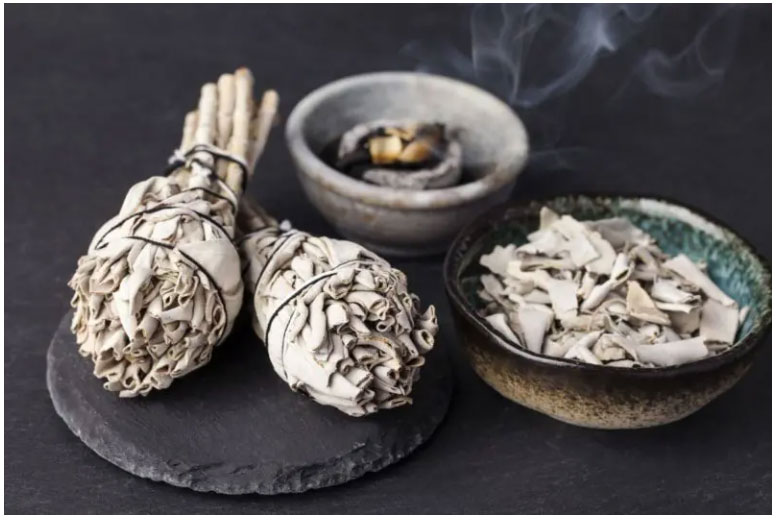Purifying Herbs
The word maculage refers to the use of these "sacred" herbs, the practice of which is part of a ceremony passed down by the ancestors. Burning sage, for example, is an ancient spiritual ritual. Although the specifics of the ceremonies and the purifying herbs used vary greatly from tribe to tribe or nation to nation, many use forms of sage (common or white) and cedar which is local to their area. Not all Native American cultures that burn herbs for ceremonial purposes refer to this practice as "smearing.
Purification by smudging has long been used to connect to the spiritual world or to improve intuition. Healers as well as lay people belonging to traditional cultures, consider burned sage to be a means of achieving healing or resolving spiritual dilemmas.
Burning herbs, also known as smudging purification, is a spiritual practice of North American Native peoples of burning white sage. The practice of cleansing by fumigation with herbs is common to almost every culture in the world. But how can we explain this craze for cleansing herbs? What are the benefits? Where do they come from?
Burning aromatics to purify the air, what does it mean?
The purification of smoke was applied in a practical and medicinal rather than spiritual way for European peasant cultures. This smoke, which could be used for spiritual, meditative, ritual or practical purposes, allowed the elimination of parasites within the home.
Burning herbs, which have the virtue of purifying the air, appeals to the spirit of the grass, which is why it is important to approach this purification with respect at the risk that this method may prove ineffective. These aromatics allow to purify, to sanitize the places in which they are burned. Moreover, the burning of herbs for emotional, psychic and spiritual purification is also a common practice among many religious, healing and spiritual groups.
This ritual is defined as "the spiritual cleansing of the house". The theory of this cleansing is that the smoke attaches itself to the negative energy in the room, and as the smoke dissipates, it carries the negative energy with it, releasing it into another space where it will be regenerated into positive energy.

Why resort to this practice? What are the benefits?
Indigenous peoples used this ritual to clean sacred spaces or to heal from certain diseases. This ritual is purifying, in fact, among the different herbs used, especially sage, most of these herbs have so-called antimicrobial properties. This means that they considerably avoid various infectious bacteria or viruses.
Also, this plant has the virtue of repelling insects and helping to relieve the symptoms belonging to certain ailments. It is highly recommended for people suffering from asthma, allergies, bronchitis and other respiratory problems to use this purification, but by paying attention to certain things, in fact, these people must wait for the smoke to dissipate before spending time in the room where the purification ritual took place, because if this is not done, they may aggravate their health problems.
Smearing, used as a ritual tool, helps to dissipate negative energy. This includes past traumas, bad experiences or negative energies from others, and can also help create a positive environment for meditation or other rituals.
Improving health
The burning of aromatic plants produces a clear improvement in mood. Tradition suggests that maculature can literally lift the spirit to banish negativity. Some research confirms this, including a 2014 study that proves that white sage is an excellent and important traditional remedy for treating anxiety, depression and mood disorders in some cultures.
The purifying herbs, once burned, help reduce stress. In fact, white sage has compounds that activate certain receptors in the brain. These receptors are responsible for raising mood levels, reducing stress and even relieving pain.
Traditionally, the maculature has been used to protect against negativity that could interfere with sleep. Sage also possesses compounds that improve sleep quality by relieving insomnia.
In addition to dissipating negative energy, improving mood and strengthening intuition, the burning of aromatics helps to stimulate cognition and alertness. Clearing the body, objects and spaces of bad energy promotes the reception of new, fresher and more positive energies. This can therefore help to increase energy levels.
Sanitation of the daily environment
Burning sage creates a fragrant smoke that is at the heart of the benefits of staining, and therefore cleans or clears specific objects. This can be useful for new purchases or gifts. However, any item can be stained.
Sage creates an exhilarating scent, which some consider to be the best of benefits. A beautiful incense with a divine aroma, white sage works as a very good deodorant.
That's why studies argue for more frequent use of medicinal smoke. Unlike scented oils, where only the scented essence of essential oils is distributed in the room by the heat of a candle, burning the herb or medicinal plant produces a cleansing and healing effect.
While the smoke is distributed in every corner of a room, it is supposed to absorb and dissolve all the residues, old information and bad energies in the room. At the same time, it distributes so-called positive energies with the scent and power of medicinal herbs.
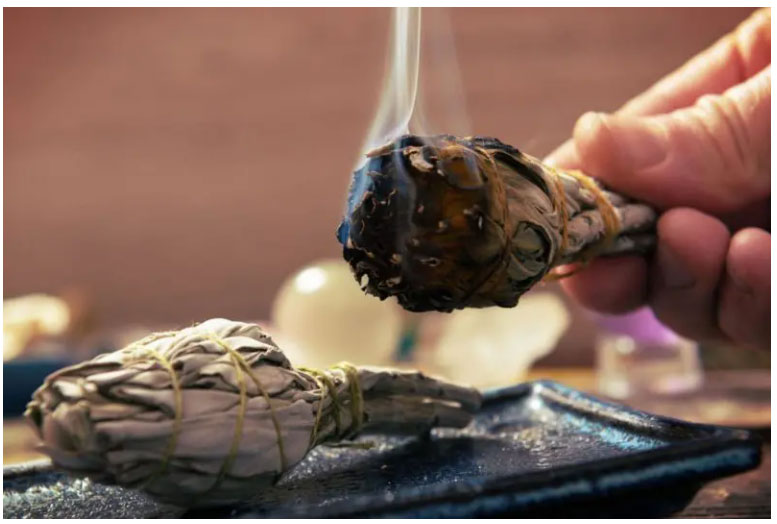
How to practice this purification based on aromatic herbs?
In the past, herbs were often dried into loose leaves and then burned on charcoal, or even thrown on the fire. Now, it is good to know that some herbs are more appreciated than others, but this does not prevent any aromatic plant from being burned. The local plants in your area will probably be the most powerful for you.
The use of a tool is part of many traditions, especially Native American traditions. Basic tools include a packet of sage, a ceramic bowl (of clay or glass) to hold the burning sage or to capture the ashes. Some also recommend matches rather than a lighter, and a feather or fan to help dissipate the smoke.
Before burning the sage (or the purifying herb you have chosen), it is recommended that you establish intentions if you are going to stain for spiritual, energetic and negativity dissipation purposes. Also, during staining, it is very important to leave a window open before, during and after so that the smoke can dissipate. Therefore, it is necessary to light the end of a packet of sage with a match. If it catches fire, extinguish it quickly.
The ends of the leaves should burn slowly, allowing the release of thick smoke. Direct this smoke around your body and space with one hand while holding the packet in the other. Then let the incense linger on the areas of your body or environment that you would like to focus on. Using a feather can also help direct the smoke. Then let the ashes accumulate in the ceramic bowl.
What are the benefits of different purifying herbs?
In purification rites, three main herbs are more frequently used for their virtues. Let's discover them now.
Sage, a herb with multiple virtues
Sage is mainly used to "wash" the outside world when entering a sacred ceremony or place. Through the smoke of medicinal sage, objects are also washed to rid them of undesirable influences.
The use of the smoke helps to bless, purify and heal the person or object that has been soiled. Culinary sage, on the other hand, is not native to Northern Europe, but is frequently cultivated in the garden. It is associated with enlightenment, cleansing, fertility, mental clarity, healing, longevity and then wisdom. Thus, white sage smoke is not only used to disperse inappropriate vibrations and evil spirits, but also to "absorb" conflict, anger or illness in a person.
It is one of the herbs that changes the composition of the air the most, thus generating negative ions that reduce our reaction to stress.
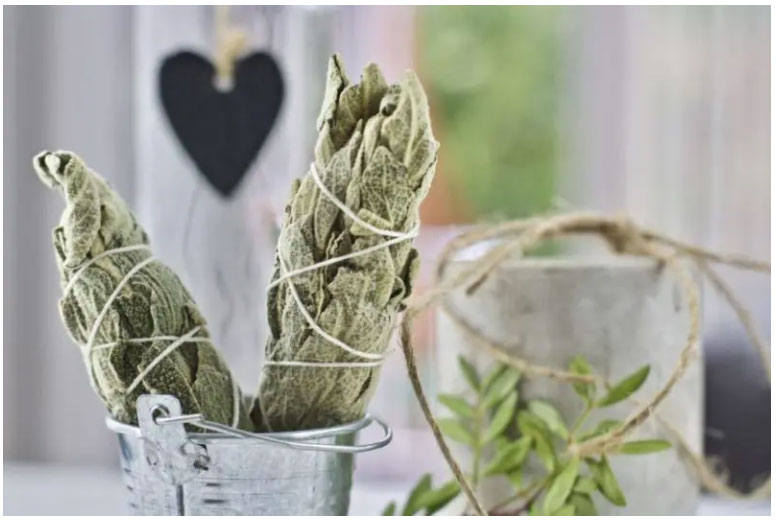
Cedar and Palo Santo, positive liberation of space
Once burned, cedar or Palo Santo wood is an excellent way to stain the air. It is a symbolic way of freeing space from persistent energy: for example, if you buy antique objects, by shaking the cedar smoke on them, you rid them of the energies of their previous owner. The main virtues of these woods are the same as those of sage, in fact, they both have benefits to chase away negative influences and prevent them from entering a sacred space. They are also considered to be antibacterial, that is to say they prevent the development of bacteria.
Sweetgrass ( Hierochloe odorata ), a return to nature
After cleaning a certain area, sweetgrass provides good energy. It is burned to remind us of the essence of the feminine and that the earth provides Man with everything he needs.
Rosemary, memory and fidelity
In particular, rosemary is a purifying and soothing herb, bringing a sense of peace to the purified environment. It is intended to attract the right energies and stimulate memory, indeed, some people have gotten into the habit of burning rosemary to improve their abilities when they are studying.
This herb is known to strengthen memory, help energy circulation, bind the soul in the body, promote fidelity while protecting space. It is often burned to create a "new beginning" in life. Whether it is to embark on a new path or to break a habit, powerful and fragrant rosemary can help to open the doors to the new.
Juniper, a better psyche
Some purifying herbs have been shown to have medicinal benefits. Juniper, a calming and protective herb, helps prevent viral infections and airborne diseases. Pine, purifying, brings forgiveness, deepens breathing, clears mucus, but also strengthens the adrenal glands. A herb fighting against airborne pathogens and regularly associated with rosemary, helps to promote courage, self-confidence while providing an increase in energy and validity, it is thyme.
Lavender, for a restful sleep
Native to the Mediterranean region, lavender is a plant, which when burned, provides a feeling of relaxation and calm. It is often used to get rid of trauma and grief and to help manage anxiety. The smoke from this purifying herb is the lightest on this list, so it is considered an excellent source of balance. Not only does its fragrance give off an enchanting aroma, but it also clears a space and promotes peaceful, deep and therefore restful sleep.
Purifying herb bunches are related to smoke purification and have been used by most indigenous peoples in America. The most common herbs in bundles are white sandalwood, cedar or aromatic herbs. They are attributed with the property of promoting ritual communication with spirits and deities, as well as facilitating internalization processes.
There are therefore many purifying herbs to burn. As we have seen, the effects differ greatly among them. It is up to you to choose the one(s) that suits you best.
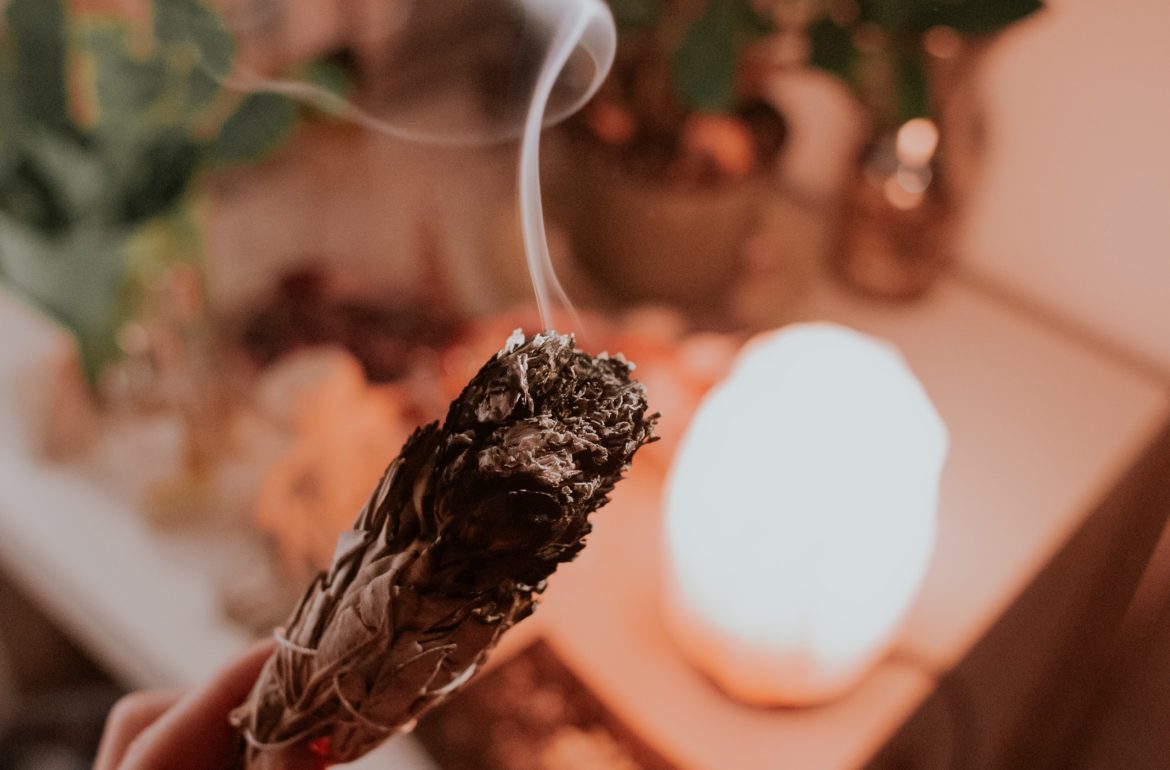
Are there any side effects or risks to burning purifying herbs?
When purifying herbs are burned properly and respectfully, then the practice is completely safe and the effects continue after the smoke has dissipated. However, there are a few good safety practices to adopt:
• When the sage is lit, water must still be provided nearby, because if you are not careful, burns or even fire are possible.
• Never let an aromatic herb burn unattended. In addition, the triggering of smoke detectors is common during this practice.
• Also, make sure to always leave a window open during the impregnation process, as smoke inhalation can sometimes be dangerous to health, especially for people with respiratory health problems who are more sensitive to smoke. These people should wait until the smoke has cleared before staying in the room where the ritual took place.
Overall, the risks are low. Still, be careful, but be reassured, the benefits are far greater than the disadvantages.
Historical perspective on these wellness plants
In ancient Egypt, the use of incense was a very important part of their customs and rituals, as purifying herbs or other ingredients had mystical properties in addition to being used in medical practices. Among Tibetan Buddhists, incense was used in monks' initiation rites and other rituals to invoke the spirits through the harmonic aromas and vibrations emanating from incense.
In almost every ancestral community on a continent, there has been the phenomenon of shamanism and, with it, the use of "sacred" plants. In spite of different languages and origins, there are multiple coincidences given by the close relationship between culture and nature, in which the plants of power occupy a central place. For millennia, these plants have been considered sacred and medicinal, making them objects of veneration and worship, giving them at the same time a deep symbolic meaning.
The use of perfume and scented smoke (such as incense) in religious and spiritual rites is a common element in many different cultures around the world, with details and spiritual meanings generally specific to the specific cultures in question. Smoke is an extremely powerful component, which is able to invade with its ethereal body the corners of any space and deeply purify it. It is for this reason that smoke has fascinated all cultures for millennia.
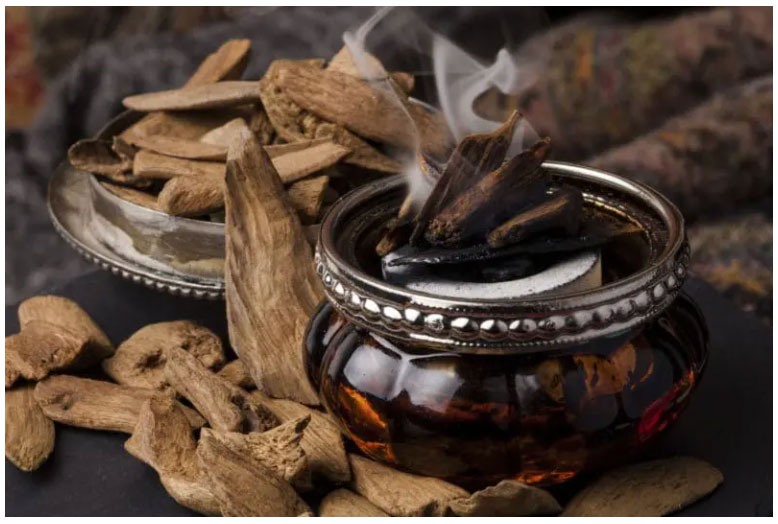
In the medical and religious tradition, burning all kinds of organic matter had a divine character because it provided bridges between this world and others. Today, incense or smoke is used by many people to furnish the home as a place to relax, purify or even decorate.
Smoking ceremonies have been known throughout the world, in many cultures, for thousands of years. Today, the old rituals are back in full swing again: with the smoking of herbs, rooms have to be freed from old information and negative energies. Smoking is an ancient tradition that was used thousands of years ago in almost every important culture of mankind as a means of purification, healing, blessing and spiritual connection.
Since plants are almost always used as they were gathered, they retain their power to grow and can help strengthen the connection between humans and the richness of animals, plants and minerals, especially in the deserts of the western United States and the Rocky Mountains, where there is a variety of different plants as there once were. Smoke, which is produced by igniting sacred herbs, was used early on by the aborigines of North and South America to purify the air. The Incas, who had their central center in South America, were a people closely linked to divine laws and nature. They knew the power of different herbs and their effects as well as their meaning. Incense was used among other things to thank our mother earth and the sun.
Nowadays, crafts are experiencing a revival, in yoga studios and meditation centers, smoking is popular. But also at home, the "holy smoke" is finding more and more followers. Whether for purifying the atmosphere, clarifying the aura, invoking a higher power or simply because it smells good and spreads comfortably. The incense they have been using since time immemorial is as close to nature as the Indian culture of North America has remained to this day.
Essential information on burning herbs
Burning purifying herbs has many benefits as a spiritual practice. Some seek to support certain health benefits of sage, for example, such as its antimicrobial properties. However, more research is needed to learn more about this topic. What about you, what herbs do you use? What benefits do you feel you get from them?


